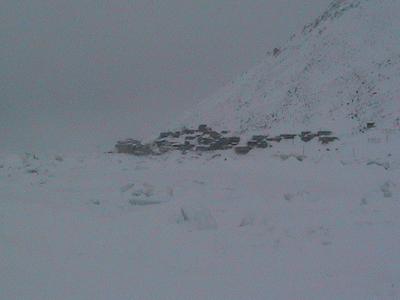29 March, 2003
Arrival at Little Diomede Island
I met Dr. Cooper at the Bering Air building in
Nome around noon where we checked our baggage,
equipment and gear before boarding the small single
prop plane. It has been snowing lightly all morning
but the pilot predicts a smooth flight.
Once airborne the low cloud cover quickly obscures
my view of the Bering Sea. I do not regain any
recognizable land or sea until we break below the
cloud cover to land at Port Clarence. This brief stop
was made to drop off a Coast Guard member at his
station along with mail and supplies.
Once airborne again the scenery changed
dramatically. Below me lay a contrasting patchwork of
white ice, varying in size and shape, floating upon a
dark colored, almost blackish green, sea. As we neared
Little Diomede Island the pieces of ice grew larger. A
beluga whale briefly broke the surface of the water
near the point where the ice pieces became one frozen
mass and our landing strip.
Our plane lands on the frozen Bering Sea, upon an
airstrip that was carved by a bulldozer, between the
islands of Big Diomede, Russia and Little Diomede,
Alaska almost directly on the International Date Line.
We are greeted by a number of native residents on
snowmobiles that have arrived to transport mail and
supplies as well as us back to the village.
It takes about five minutes to get to the village.
The plane has already left before we make it to the
halfway point to the village. My Diomede welcome was a
blast of frigid wind that seems to instantly freeze my
face and starts my eyes watering. A quick adjustment
to my parka hood brings some warm relief.
Although very cold, around 10 degrees F and about
minus 15 wind chill, the day is very bright and sunny.
We unloaded our gear into the school where we will be
staying conducted a few brief introductions then went
to work. Our team split up into two groups half of
which went to work on the seawater intake and purge
valves in the instrument shack while the remaining
three of us trekked out onto the ice to insulate and
bury water lines below ice. The insulation protected
the line from freezing and burying it provided
protection from snowmobile or other damage.
Two other members of the team were introduced to
me, Dr. Lou Codispoti, University of Maryland and
Jerry, who serves as our polar bear guard while we are
working on the ice.
As I look out over this frozen sea it resembles a
large white field of huge, thick, frosty eggshells
strewn in jagged piles as high as six feet plus. Other
than the occasional dark spot on Big Diomede
everything is white. From the school buildings looking
north or south dark lines are visible. This area marks
where the open sea meets the frozen mass of ice .The
unburied section of black waterline snaking across the
ice offers the only real identifiable mark on this
landscape.
Tomorrow there will probably be no journal posted.
I am having difficulty with downloading photos to
disks or computer since the cable adapters were lost
during one of the many airport inspections. E-mail is
also very slow and inconsistent please be patient with
regards to my journals.
Thank you.

Diomede Village
Contact the TEA in the field at
.
If you cannot connect through your browser, copy the
TEA's e-mail address in the "To:" line of
your favorite e-mail package.
|
